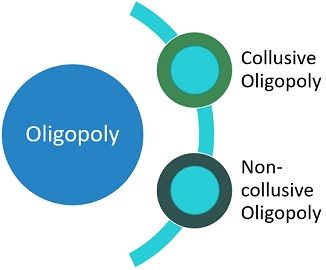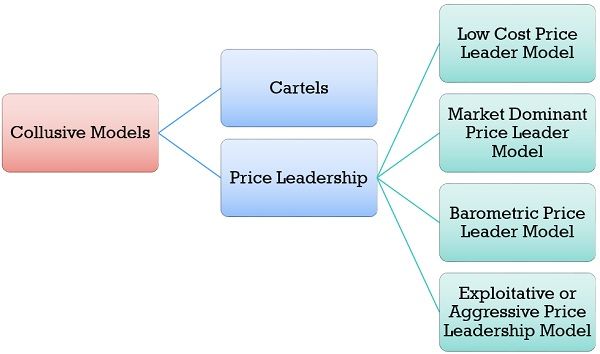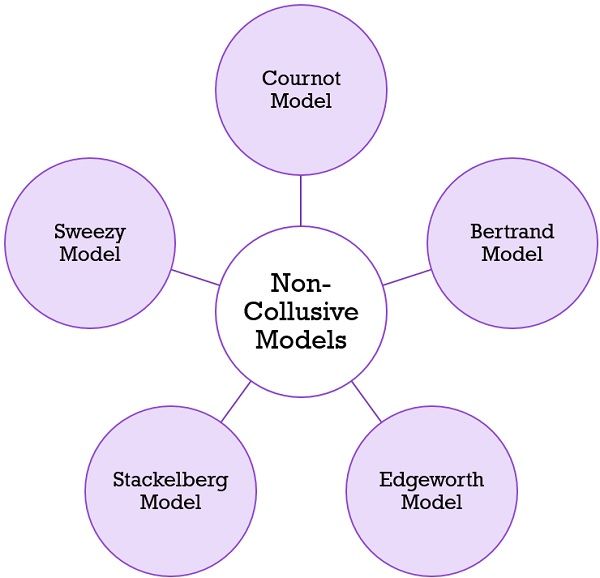 The literal meaning of the word ‘oligopoly‘ is ‘competition among few‘. Collusive Oligopoly is when the oligopolists come in formal or informal agreement with one another to avoid competition among themselves. On the other hand, in a non-collusive oligopoly, the firms tend to compete with each other, by setting their own price and output policy, which is independent of the other firms.
The literal meaning of the word ‘oligopoly‘ is ‘competition among few‘. Collusive Oligopoly is when the oligopolists come in formal or informal agreement with one another to avoid competition among themselves. On the other hand, in a non-collusive oligopoly, the firms tend to compete with each other, by setting their own price and output policy, which is independent of the other firms.
What is Oligopoly?
Oligopoly is a type of market characterised by a few firms offering either homogeneous product or differentiated product for sale in the market.
For example Telecom service providers.
When the firms sell homogeneous products, they are called pure oligopolies, such as cement, steel, aluminium, etc., whereas if the firms are selling differentiated products, it is called impure or differentiated oligopoly, such as cold drinks, automobiles, etc.
This post is all about the difference between collusive and non-collusive oligopoly.
Content: Collusive Oligopoly Vs Non-Collusive Oligopoly
Comparison Chart
| Basis for Comparison | Collusive Oligopoly | Non-Collusive Oligopoly |
|---|---|---|
| Meaning | A Collusive Oligopoly is one in which the firms cooperate and not compete, with one another with respect to price and output. | A Non-Collusive Oligopoly is one wherein each firm in the industry pursues a price and output policy that is independent of competitors. |
| Profit | Collective profit | Individual profit |
| Objective | To reduce competition and to create and maintain entry barriers. | To maintain competition and to work independently as a normal business. |
| Price and Output decision | Mutual or Interdependent | Independent |
| Formation of monopoly | Yes | No |
| Price benefit | Consumers receive fewer price benefits, due to monopoly. | Consumers receive price benefits due to competition between sellers. |
| Brand Loyalty | No need to incur expenses to create brand loyalty. | Powerful advertisement creates brand loyalty. |
Definition of Collusive Oligopoly
Collusive Oligopoly refers to a form of oligopoly in which the competing firms collude so as to minimize competition and maximize joint profit by reducing the uncertainties arising due to rivalry and selling the goods and service at a monopoly price. In this, the oligopolists enter into a contract to establish the levels of price and output, in the market.
It can be found in the industries where the products sold by the firms are homogeneous. In this type of oligopoly firms know that if they increase or decrease their prices, there will be a shift in the demand curve, as the products offered by all the firm are homogeneous. And so, the customers can make purchase indifferently from any firm. Hence, it may lead to a huge loss of profit to a price war.
Hence, by deciding not to compete with each one another, they can set up a monopoly price to be charged and an agreement to be reached on the output produced by each firm. By doing this, oligopolists can achieve the maximization of joint profit, i.e. by working as a single firm. Collusion can be of two types:
- Cartels: Producer firms enter into a formal agreement that states the price and output, of each firm that are members of the cartel. So, in a cartel firms jointly fix the price and output policy by way of agreements. For Example OPEC
- Price Leadership: There is an implicit understanding between the oligopolists to coordinate prices, wherein the dominant firm initiates the price changes and all the other firms follow, or match the change in price.
It can be used to prevent uncertainty causing due to interdependence, prevent price wars, avoid competition, increase prices and also increase profit margins.
It can be an open agreement or a tacit (Secret) one. In most nations, an open agreement concerning the formation of a monopoly is considered illegal, and that is why the firms often go for tacit agreement.
Also Read: Difference Between Monopoly and Oligopoly
Definition of Non-Collusive Oligopoly
Non-collusive Oligopoly is the oldest theory of competition. It refers to the oligopoly in which firms are in competition with each other. In a non-collusive or non-cooperative oligopoly, the firms survive in a strategic environment, as they begin with a particular strategy without colluding with competitors.
So, in a non-collusive oligopoly:
- Firms are independent of each other.
- There are a large number of firms.
- Barriers to entry are very less.
- It has strict government regulations.
- Each firm develops an expectation as to what the rivals firms are about to do.
Therefore, the firms have to consider the possible actions of competitors and how to react. So, a non-collusive oligopoly is characterised by price inflexibility. Each firm in a non-collusive oligopoly attempts to increase its market share by way of competition. Hence, the firms prefer competition over collusion, as a way of profit maximization.
Also Read: Difference Between Perfect Competition and Monopolistic Competition
Key Differences Between Collusive Oligopoly and Non-Collusive Oligopoly
As we have understood the meaning and concept, let us now take a look at the difference between collusive and non-collusive oligopoly:
- Collusive Oligopoly can be defined as the form of oligopoly wherein the sellers eliminate competition by way of a formal or informal agreement. As against, a non-collusive oligopoly is one in which each firm sets its own price and level of output and compete in the market.
- In a collusive oligopoly, firms act as a single monopoly and intend to increase their collective profit, instead of individual profit. As against, in a non-collusive oligopoly, the firms intend to increase their own profit and determine the volume of output to be produced, in an assumption that competing firms would not change the quantity supplied by them.
- Firms operating under oligopolistic competition often enter into a collusive agreement to avoid uncertainty causing due to interdependence, to avoid price wars and cut-throat competition. On the other hand, the aim of a non-collusive oligopoly is to maintain competition and to work independently as a normal business.
- The price an output decision under collusive oligopoly is mutual and interdependent, whereas, in the case of non-collusive oligopoly, the price and output decision is independent of other firms.
- In a collusive oligopoly, firms agree to set prices and output jointly, so they act as a single firm, which leads to the formation of a monopoly. But, in a non-collusive oligopoly, as no firms collude with one another and a sense of competition exists among them, monopoly does not form.
- As collusive oligopoly leads to the creation of a monopoly, consumers receive less benefit, as the products are offered for sale to the consumers at the same price by all the sellers. Unlike, in a non-collusive oligopoly, monopoly does not exist, which results in competition among the seller firms and so, the consumers get price benefits.
- In a collusive oligopoly, no need to incur expenses to create brand loyalty. On the other hand, in a non-collusive oligopoly aggressive advertisement creates brand loyalty.
Oligopolistic Models
- Cartels: Initially, the word ‘cartel’ is used for those agreements wherein a common sales agency exists which carries out the selling activities of all the member firms. However, at present, all the formal, informal and tacit agreements that took place between oligopolists are termed cartels. As they tend to reduce competition, these are considered illegal in many countries.
- Price Leadership: In a price leadership model, one dominant firm fixes the price of the goods while the rest of the rivals follow it.
- Low-Cost Price Leader: To maximize the profit, a low-cost firm sets a price lower than the profit-maximizing price of the high-cost firm so that high-cost firm will be forced to lower down their price.
- Market Dominant Price Leader: As per this model, there is one of the few firms in the industry, producing a substantially large volume of the total output of industry and so they dominate the market. The firm forecast its demand and sets the price accordingly which increases its profit.
- Barometric Price Leader: In this model, the oldest, largest, most experienced and respected firm acts as custodian to other firms, which safeguards the interests of all the firms. The firm analyses the market condition, as to various factors like demand, cost of production, competition, etc., and decides a price, which is the best possible price, from the point of view of all the firms in the industry.
- Exploitative or Aggressive Price Leadership: Under this, one dominant firm marks its leadership by pursuing aggressive pricing policies and thus forces other firms existing in the industry to follow the same price regime.
- Cournot Model: This model describes a structure in the industry wherein competitors offer the homogenous product. They compete on the amount of output produced, independently and concurrently.
- Bertrand Model: It is an economic model, wherein few firms produce homogeneous goods and sell them to many customers. Identical products are produced at a constant marginal cost. Each firm in the industry considers the price of competitors as fixed, at the time of determining the price to be charged. So the prices are set up independently.
- Edgeworth Model: In this model, the firms sell homogeneous product and they have the same cost function with zero marginal cost. It is assumed that no duopolist can produce the output, which is as large in size as the competitive market.
- Stackelberg Model: In this model, one firm is a market leader while others are followers. the firms offer homogeneous products and they compete on the basis of output. Further, the output is chosen by the firms sequentially. The leader firm establishes quantity prior to any other firm. It is suitable when a large firm dominates the entire industry.
- Sweezy Model: Also known as the kinked demand model. As per this model, there are only a few firms in the market that sells differentiated products to consumers. There are barriers to the entry of new firms. It is believed that the firms will follow price reduction, but won’t follow price hike.
Conclusion
In a non-collusive oligopoly, the firms operating in the industry are rivals, due to their interdependence. In contrast, in a collusive oligopoly, the competing firms come together to remove the uncertainly causing out of inherent rivalry among the firms.








Purnima says
very nice explanations
Areej Fatima says
Mashallah very nice explanation . Keep it up .